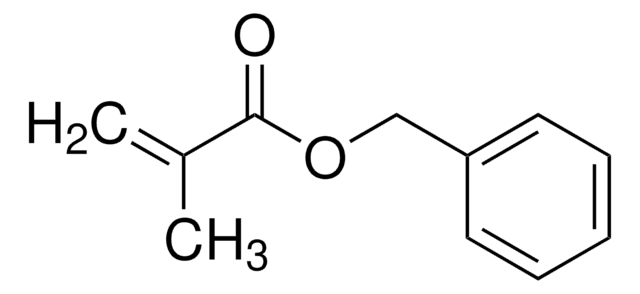235865
Butyl methacrylate
99%, contains monomethyl ether hydroquinone as inhibitor
About This Item
Productos recomendados
vapor density
4.91 (15 °C, vs air)
vapor pressure
2 mmHg ( 20 °C)
assay
99%
form
liquid
autoignition temp.
562 °F
contains
monomethyl ether hydroquinone as inhibitor
expl. lim.
2-8 %
refractive index
n20/D 1.423 (lit.)
bp
162-165 °C (lit.)
density
0.894 g/mL at 25 °C (lit.)
storage temp.
2-8°C
SMILES string
CCCCOC(=O)C(C)=C
InChI
1S/C8H14O2/c1-4-5-6-10-8(9)7(2)3/h2,4-6H2,1,3H3
InChI key
SOGAXMICEFXMKE-UHFFFAOYSA-N
¿Está buscando productos similares? Visita Guía de comparación de productos
Categorías relacionadas
General description
Application
- A Monomer to synthesize waterborne butyl methacrylate (co)polymers latexes via emulsion polymerization for the development of coating materials for slow release-fertilizers.
- A matrix polymer in the preparation of LDH/poly (butyl methacrylate) nanocomposites, which can improve the mechanical properties and thermal stability of the resulting nanocomposites.
- A monomer to synthesize styrene and butyl methacrylate copolymers for use in leather finishing. Increasing the BMA content of the copolymer increases the water resistance and decreases the water vapor permeability of the leather.
- A monomer for the preparation of monolithic columns on microfluidic chips. These columns can be used for a wide range of applications, such as the separation and analysis of complex mixtures of compounds, the preconcentration of samples, and the development of new microfluidic analytical devices.
signalword
Warning
hcodes
Hazard Classifications
Eye Irrit. 2 - Flam. Liq. 3 - Skin Irrit. 2 - Skin Sens. 1 - STOT SE 3
target_organs
Respiratory system
Storage Class
3 - Flammable liquids
wgk_germany
WGK 1
flash_point_f
119.3 °F - closed cup
flash_point_c
48.5 °C - closed cup
ppe
Eyeshields, Faceshields, Gloves, type ABEK (EN14387) respirator filter
Certificados de análisis (COA)
Busque Certificados de análisis (COA) introduciendo el número de lote del producto. Los números de lote se encuentran en la etiqueta del producto después de las palabras «Lot» o «Batch»
¿Ya tiene este producto?
Encuentre la documentación para los productos que ha comprado recientemente en la Biblioteca de documentos.
Los clientes también vieron
Artículos
Tissue engineering has become a key therapeutic tool in the treatment of damaged or diseased organs and tissues, such as blood vessels and urinary bladders.
Nuestro equipo de científicos tiene experiencia en todas las áreas de investigación: Ciencias de la vida, Ciencia de los materiales, Síntesis química, Cromatografía, Analítica y muchas otras.
Póngase en contacto con el Servicio técnico











